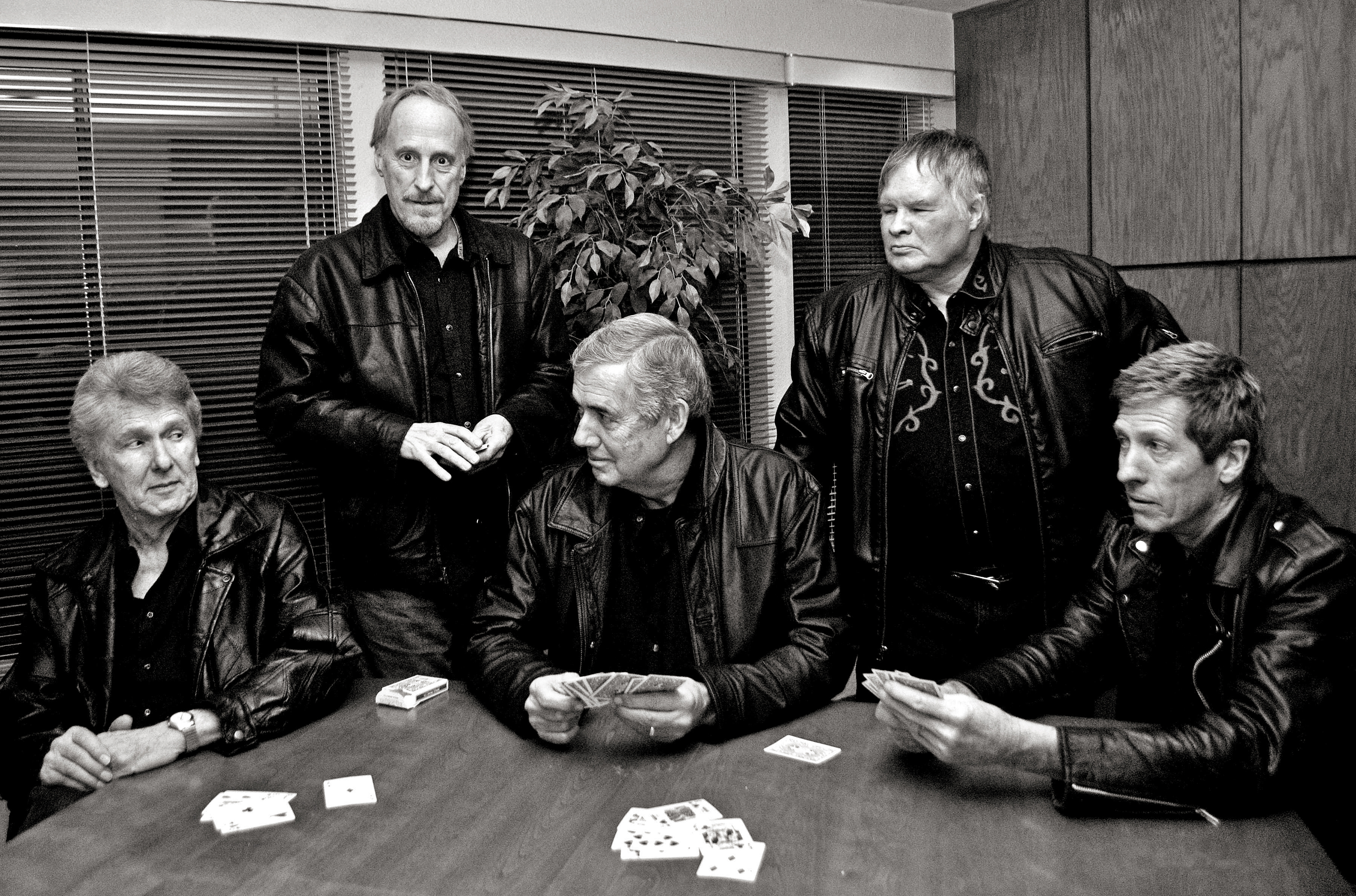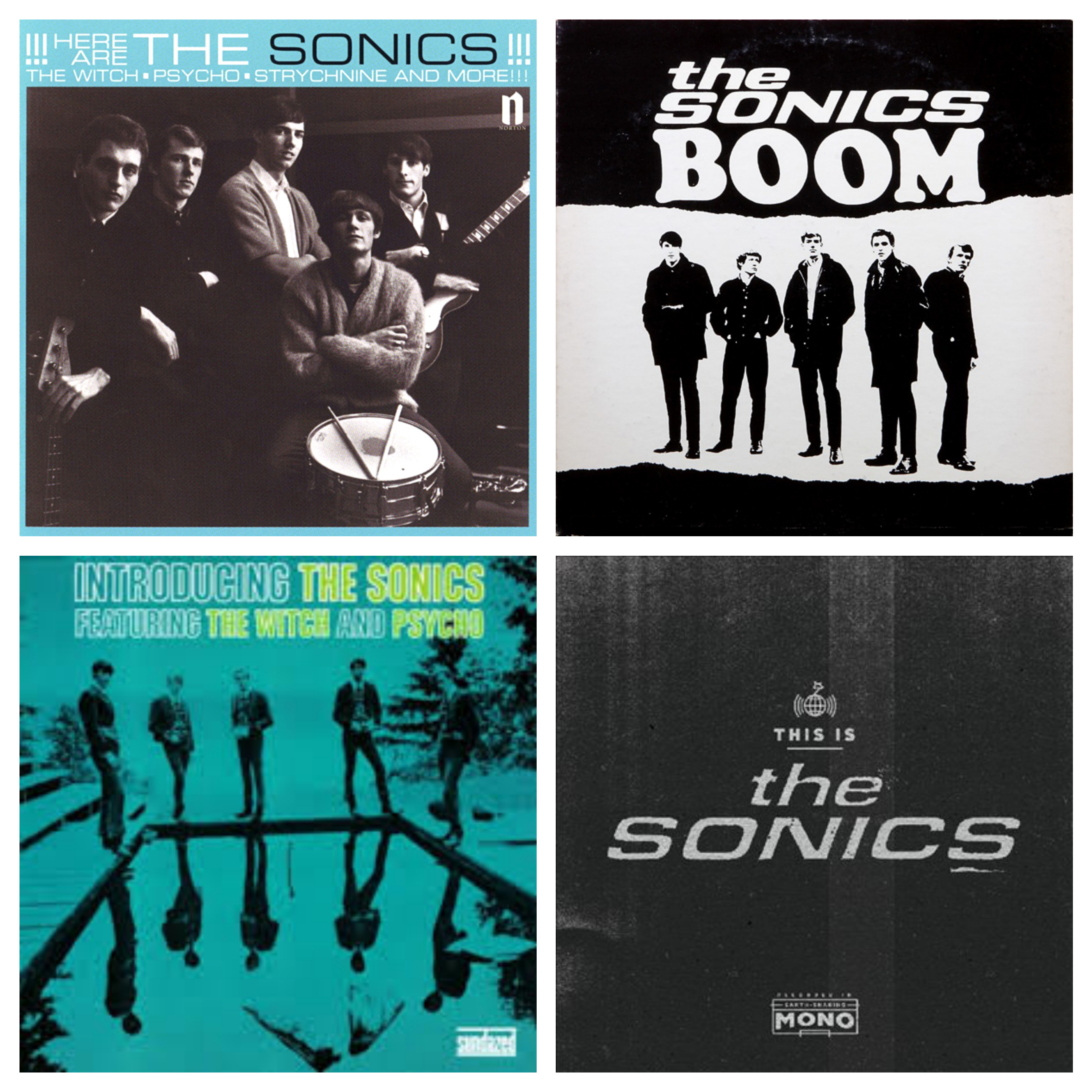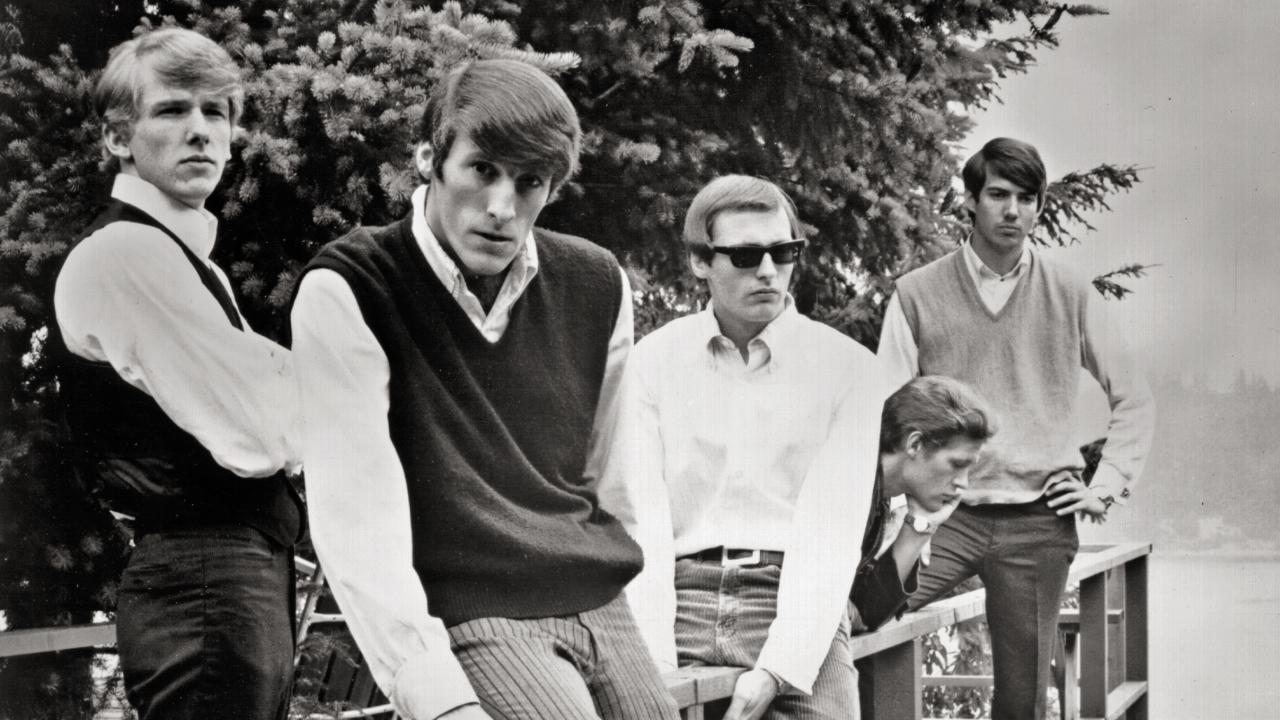Jon Weiss doesn’t give up easily. As founder and curator of Cavestomp!, New York’s annual celebration of the great and the good in garage rock, Weiss has coaxed reunion shows from such 60s legends as The Monks, The Creation, ? & The Mysterians, the Chocolate Watchband and The Standells, to name just a few.
Some were easier to persuade than others, but one band of bygone miscreants proved a particular challenge. The original line-up of The Sonics, a primal quintet who once tore a hole through the rock’n’roll scene in the Pacific Northwest, hadn’t played together in more than three decades. Weiss’s initial offer to regroup for Cavestomp! was turned down flat. Undeterred, he kept asking. Then, in November 2007, The Sonics finally agreed to give it one more shot, at least for old times’ sake.
“He harassed us for several years, asking us to re-form,” explains guitarist Larry Parypa, who co-founded The Sonics in 1960. “And we kept saying no. All of us in the band were of the opinion that nobody cared much about us. We’d all been out of the music business for thirty or forty years. But we talked about it and decided to get back together. I don’t think any of us were thinking of doing anything beyond that New York show.” “We had no idea what we’d sound like after all those years,” adds singer, keyboardist and chief songwriter Jerry Roslie. “So we got together for a jam and thought, well, it’s rusty – it’s real rusty – but with a bit of work we might just be able to do it. We practised on and off for two or three months, and finally we told him we thought we could pull it off.”
The gig was a resounding triumph, the band’s malicious punk’n’roll finding a new generation of fans reared on contemporary noise bringers such as the White Stripes, The Strokes and The Hives. The latter, it turned out, were on the same bill. After the show the Swedish upstarts made a beeline for The Sonics, told them how they began by trying to emulate them, and suggested the veterans now had a huge fan base throughout Europe. The Sonics found out for themselves when they accepted an offer to tour the following year. “When we got invites to play London and Europe, we discovered this whole underground thing that we hadn’t even been aware of,” says Parypa. “We didn’t have a clue there was that much interest in us. We were still kinda shocked by the whole thing.” The Sonics’ influence had also spread back home. The Cramps had doffed their cap as early as 1980, when they covered The Sonics’ _Strychnine _ on their debut LP Songs The Lord Taught Us. Kurt Cobain had been a fan, as were fellow grunge heroes Mudhoney, who even formed a tribute band, The New Strychnines, for an album of reworked Sonics tunes in 2000. Others who cited them as an influence and covered their songs included The Black Keys, Jello Biafra, the Flaming Lips, Screaming Trees and the White Stripes. Jack White called them “the epitome of sixties punk”, adding: “Life becomes better after buying a Sonics record, or at least more tolerable.”

This concerted wave of fandom was based on the slimmest of legacies. The Sonics in their original form released just three albums, but two of them (1965’s Here Are The Sonics and the following year’s Boom) contained some of the most ferocious garage rock of its era. Their greatest songs – The Witch, Psycho, Strychnine, Boss Hoss – were as uncompromising as their curt titles suggested, driven by thumping beats, wailing sax and guitar, and Roslie’s throat-ripping yelp. Washington State threw up an uncommon number of great bands at the turn of the 60s, among them The Wailers, The Kingsmen and The Ventures, but none of them blew harder than The Sonics. Parypa is strikingly modest when trying to figure out why. “We weren’t great musicians at all,” he insists. “Jerry and I always felt like our music wasn’t legitimate. The Wailers, who were so much better, evolved from instrumental rock’n’roll to R&B. We’d listen to their songs and do them our way, because we weren’t good enough to do them their way. So Jerry would scream instead of sing, and Bob Bennett would be pounding the drums so loud that everybody else had to turn up just to get heard. We ended up just hammering our instruments and being very aggressive. We didn’t discuss it, it wasn’t a plan: ‘Hey, let’s invent garage rock.’ We just played the instruments the best that we could, which ended up sounding real primal.” “We were just a bunch of teenagers who wanted to play rock’n’roll,” Roslie adds. “And fortunately the whole band felt the same way, in that it was all about taking no prisoners, give it everything you’ve got.” Parypa’s embryonic version of The Sonics included brother Andy on bass, but it wasn’t until 1963 that the classic line-up took shape. Roslie, Bennett and sax player Rob Lind had been doing the rounds in Tacoma for a couple of years as The Searchers. When the trio hooked up with the Parypa siblings, things started to move. The Wailers connection was key. Bassist ‘Buck’ Ormsby, co-owner of the Etiquette label, signed The Sonics after hearing a gruff demo of The Witch. He swiftly earmarked it for the band’s debut single. “I think The Witch was actually cut in a radio station’s recording booth, where they would usually record commercials,” Parypa says. “I’m not sure that it was even two-track. But I know we were playing so loud in there that the engineers were upset at the sound and distortion we were getting, with needles in the red.” Etiquette started issuing the song to local DJs, and it soon became a regional hit, selling around 20,000 copies in three weeks. Psycho, another proto-punk classic from Roslie, did similar business. Ormsby duly booked The Sonics into Kearney Barton’s Audio Recording studio in Seattle for a full album. “Barton and Etiquette let us do what we needed to do in order to play the songs our way,” says Parypa, “with lots of distortion, loudness and bleeding microphones. We wanted it to be powerful and mean-sounding, like we were playing with abandon. And, of course, Jerry’s lyrics were so unusual.” Roslie’s choice of subject matter – mad ex-lovers, evil wenches – was in direct contrast to the sentimental fodder that clogged up the pop charts. “Before we ever recorded, I knew I screamed a lot,” he explains. “So I thought I might as well have a reason for it: ‘Let’s see, there’s witches, a girlfriend you can call a psycho, drinking strychnine.’ Any of those things can make a person scream.” The pure savagery in his voice came from an honest desire to give everything of himself: “I always felt best when I gave a hundred per cent. It’s just a natural thing in that I feel better when I sing hard, rather than doing love songs. The Sonics tried doing love songs, but we always ended up rocking our socks off and going crazy.” All this brain-bashing kineticism lent itself to the live circuit around Tacoma and Seattle, where The Sonics became a must-see. They held court at venues like the Red Carpet and the Tacoma Armory. They also found themselves regulars at the Seattle Coliseum, where they opened for touring heavyweights such as The Kinks, The Beach Boys and The Righteous Brothers. “We weren’t technically great, but we let our emotion come through,” Parypa recalls. “Jerry would get excited and start screaming, which people just weren’t doing back then.”

Sonics gigs were not without incident. Parypa cites one particular instance in Tacoma that presages of one of punk’s less endearing rituals. “We were up there playing, and this guy and his friends singled me out to spit at,” he says. “So I actually got off stage while we were halfway through The Witch, laid my guitar down and got right into it. The cops broke us up and they closed the dance down.” If The Sonics’ music suggested they were an unruly bunch of oiks, the truth was that they were anything but. Both Parypa brothers and Lind were students at the University of Washington, and Roslie admits that their way of life was “pretty tame in relation to the music we were making. We’d have an occasional beer, but we never got into heavy drugs or anything.” Despite the regional adulation, both Here Are The Sonics and Boom failed to make an impression on the US charts. The band were hopeful of a breakthrough after being invited to play on several national TV shows, but Etiquette’s reluctance to break their travel budget meant they were forced to stay home instead. Things came to a head in 1966 when The Sonics decided to leave Etiquette and sign to Seattle’s Jerden label. The band were packed off to Gold Star Studios in LA to cut a third album. But Introducing The Sonics, released the following year, was a disaster. The engineering team, led by Larry Levine, fresh from recording Herb Alpert & The Tijuana Brass, failed to bottle the flash-lightning of The Sonics’ sound. “When we went to California,” says Roslie, “the engineer said: ‘You guys don’t have to play so loud. Turn it down and we’ll take care of all the sound stuff in the booth.’ We were all thinking: ‘How does he know what we want to do for our sound?’ So that kinda set a mood for no creativity. Suddenly we had rules, and we’d never had that before.” Parypa simply dismisses it as “a terrible album”. Over the next couple of years The Sonics fell apart. Lind became a US Navy carrier pilot in Vietnam, Andy Parypa took up a teaching post at school and the others drifted away. “It just kinda happened,” says Larry. “Bob wanted to try some different stuff, and the draft was breathing down my neck. I think it was just over. We had nothing more to say, really.”
Save for a one-off live reunion in 1972, the band seemed consigned to history. But The Sonics legend refused to die altogether, their spirit kept alive via obscure reissue labels and by the patronage of those who’d covered their songs. The Sonics have travelled far and wide since Cavestomp!. But what’s most heartening is the fact that they’ve just released This Is The Sonics, their first studio album since that ill-fated 1967 record. Three original members are still around – Roslie, Lind and Larry Parypa – and, astonishingly, the passage of time hasn’t dimmed them an inch. The record, produced by White Stripes associate Jim Diamond, is a howling exclamation of noise. “We wanted to just be The Sonics, the way we used to play,” says Roslie. “Like a crazy bunch of kids from the Pacific Northwest who didn’t know how to play soft.” Larry Parypa still can’t quite take it all in. “We never thought that we’d be able to get back up there and compete with younger bands in terms of energy. Can a bunch of seventy-year-olds still rock’n’roll? It looks like we can.”
Super Sonics Sounds
Five Sonics songs that helped turn the band into living legends.
The Witch (1964) The Sonics’ startling debut single starts off on a blues tip before erupting into clouds of fuzzed-up freak-punk. Larry Parypa’s riff never lets up for a second, while Jerry Roslie’s lyric suggests he’s probably hanging out with the wrong type of girl.
**Psycho (1965) ** Rock’n’roll meets the garage revolution head-on. Rob Lind’s distorted sax jostles for space with Parypa’s furious guitar, pushing needles into the red for the duration. Roslie, meanwhile, is at his yelping best on arguably the quintessential Sonics tune.
Strychnine (1965) The Sonics at full pelt. Yammering piano, dirty sax and a voice boiling with youthful desperation: ‘Wine is red, poison is blue/Strychnine is good for what’s ailin’ you…’ It was later covered by The Fall, The Cramps and the Flaming Lips.
Have Love Will Travel (1965) Written by Richard ‘Louie Louie’ Berry. The Sonics’ version, cut in one take at three in the morning, sounds like an unholy alliance of Jerry Lee Lewis and the Stooges. It’s also definitive, as borne out by its use in TV ads for Land Rover, BMG and Modello beer.
Cinderella (1966) The opening shot from second album_ Boom_. Roslie pines for the one who got away over a bare-bones rhythm, capped with a rasping solo from Parypa.

